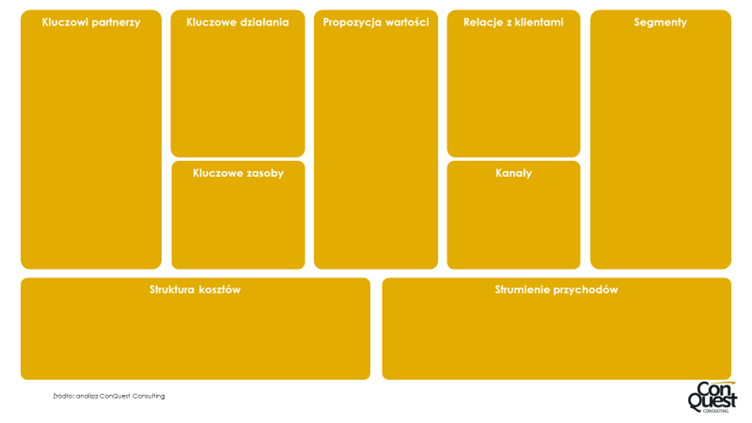12.08.2022
The Osterwalder model, or how to distance the competition in modern business?
Key information:
- Osterwalder's model, also known as the Business Model Canvas, distinguishes itself from traditional business models through its approach focused on nine core elements of value creation and profit generation.
- The model offers added value by focusing on the company's key business areas, such as customers, offerings, infrastructure and financial position, among others.
- For the model to function properly, it is necessary to properly define the customer segment and develop a unique value proposition.
- To be successful, a company should identify the right communication, distribution and sales channels to effectively reach different customer segments.
- Managing the revenue stream and cost structure is essential for maintaining the financial stability of the company.
- Osterwalder's model is a tool that replaces the traditional business plan by providing a simple, flexible and transparent outline of the business, enabling market analysis and easy introduction and modification of business plans.

What is the Osterwalder model?
Osterwalder's model, created by Alexander Osterwalder, is one of the best-known business models. The Swiss economic theorist, in collaboration with 470 practitioners from 45 countries, developed the innovative model, also called Business Model Canvas, and described it in the book "Creating Business Models. A Visionary's Handbook."
But what actually sets Osterwalder's model apart from traditional business models? Why can choosing a model developed by a Swiss economist generate much more added value than other models created by well-known economists?
The Business Model Canvas is based on nine basic elements, embedded in the company's strategy for creating value and generating profits from it. Osterwalder and his team emphasized the fundamental areas of the business:
- Customers,
- Offer,
- Infrastructure,
- Financial position.
To better understand Osterwalder's model, it is worth taking a closer look at each of the elements of this template.
What are the elements of the Osterwalder model?
The solution we describe, is used to create and describe business models. It consists of nine key elements that help understand, describe and plan various aspects of a company's operations. Feel free to read more about them later in the article!

Customer segments
In order to better meet the needs of customers, it is necessary to divide them into separate groups whose members share certain common characteristics. Such a division helps to better understand their needs and, consequently, to more accurately define the value proposition, which is one of the key aspects of proper business operation.
Value proposition
Once we have determined which target groups we are focusing on, we can move on to the next element of the model. A value proposition is a set of products and services that a company wants to offer customers in a way that meets their expectations and differentiates itself from the competition.
Channels
The element that connects the product/service to the customer is the channels:
- communication - The means or medium by which information is transmitted between sender and receiver.
- distribution - The path in which a product is transferred from the manufacturer to the final customer.
- sales - The path an enterprise uses to reach customers and complete business transactions.
They indicate how the company delivers the value proposition to specific customer segments. When analyzing this element of the business model, it is worth answering questions such as how to connect with customers and which channels we should use to reach them most effectively.
Customer relations
Another element included in Osterwalder's model is customer relations. These should be clearly defined in order to effectively attract and retain regular buyers. Depending on the specific customer segment, their level of commitment, trust, and communication and interaction, the type of relationship can vary from personal to fully automated.

Revenue streams
The primary motivation for starting your own business is the desire to make money. In exchange for the value delivered to customers, the company earns revenue. To ensure a steady stream of revenue, a business must answer the question of what value proposition and how much customers are willing to pay. When designing this part of the model, the entrepreneur should consider what value proposition the target customers will be willing to pay for. The next step is to determine the preferred form of collection. Depending on the nature of the product or service offered and customer preferences, possible options include retail, wholesale, rental, barter and many others.
Key resources
Resources are needed in any company to produce a product or service, and thus the value it wants to deliver to the customer. Depending on the company's field of activity, these can be tangible resources, e.g. raw materials, production materials, infrastructure, or intangible resources, e.g. human capital or cash.
Key activities
In order to create value, in addition to resources, it is necessary to have activities, i.e. the totality of activities undertaken by a company that will lead to selling a product or service to a customer, maintaining a relationship with the customer, as well as generating revenue. They depend, of course, on the type of business, e.g. for a supply company they will be different than for a consulting firm. Among other things, they will be differentiated by the very type of service offered, the process of delivering value, or the interaction with the customer and the business model.
Key partners
Today, a small percentage of companies are entirely self-sufficient. For this reason, an extremely important aspect of running a business is establishing the right relationships with suppliers and collaborators, the selection of which determines the smooth operation of the company. For example, working with the right suppliers can ensure that a company has access to high quality raw materials, materials or products, as well as competitive prices. Suppliers can also influence the timeliness of deliveries, which is important for the production process and customer service.
Cost structure
Running any business is about revenue on the one hand, but one must not forget about costs as well. In order to increase profits, which is what every company strives for, costs must be minimized. For this reason, establishing a specific cost structure allows you to make informed financial decisions and manage the company's budget. First of all, it is worth keeping in mind operating costs, related to production, sales, marketing, as well as management and administration.

How does the Osterwalder model differ from a traditional business plan?
The main premise of the traditional business plan is an in-depth and long-term analysis of the market, the strengths and weaknesses of the product, various possible scenarios and forecasts for the company's development. This approach has many of its undeniable advantages, but let's check out, So what speaks in favor of Osterwalder's model?
Unlike a traditional business plan, which is usually a dozens of pages document full of tedious text, Business Model Canvas is a simple sketch of the business, with the help of which you can easily present, among other things, a simple competitive analysis, or market.
Another advantage of this business model is the ease of its creation, modification and implementation. Osterwalder's model is also characterized by a high degree of transparency, which facilitates the correct layout of each of the aforementioned elements.
Another important benefit of this method is the ease of presenting your idea to people whose comments can help improve the existing business outline. All these features make BMC increasingly popular among entrepreneurs, consultants and directors.
And are you ready to successfully bring your business ideas to life? Contact us And try out the Osterwalder Model in practice! Find out how much easier it will make the process for you!




